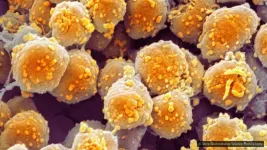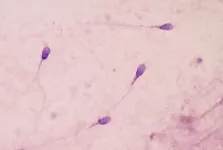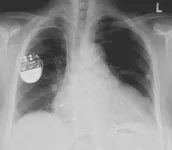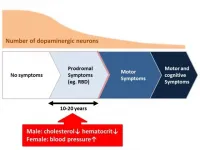(Press-News.org) New study identifies a bizarre new species suggesting that giant marine lizards thrived before the asteroid wiped them out 66 million years ago.
A new species of mosasaur - an ancient sea-going lizard from the age of dinosaurs - has been found with shark-like teeth that gave it a deadly slicing bite.
Xenodens calminechari, from the Cretaceous of Morocco, had knifelike teeth that were packed edge to edge to make a serrated blade and resemble those of certain sharks. The cutting teeth let the small, agile mosasaur, about the size of a small porpoise, punch above its weight, cutting fish in half and taking large bites from bigger animals.
Dr Nick Longrich, Senior Lecturer at the Milner Centre for Evolution at the University of Bath and lead author on the paper, said: "66 million years ago, the coasts of Africa were the most dangerous seas in the world.
"Predator diversity there was unlike anything seen anywhere else on the planet. The new mosasaur adds to a rapidly growing list of marine reptiles known from the latest Cretaceous of Morocco, which at the time was submerged beneath a tropical sea.
"A huge diversity of mosasaurs lived here. Some were giant, deep-diving predators like modern sperm whales, others with huge teeth and growing up to ten meters long, were top predators like orcas, still others ate shellfish like modern sea otters - and then there was the strange little Xenodens.
"They coexisted with long-necked plesiosaurs, giant sea turtles, and saber-toothed fish. The new mosasaur adds another dangerous predator to the mix."
The discovery also adds to the diversity of marine reptiles in the late Cretaceous. This suggests their diversity peaked just before an asteroid hit 66 million years ago, wiping out marine reptiles and the dinosaurs.
"We're still learning how diverse the mosasaurs were," said Longrich. "And whenever we think we have them figured out, another one turns up."
The fauna lived in the million years before an asteroid hit the earth at the end of the Cretaceous period, ending the reign of the dinosaurs and wiping out 90 per cent or more of all species on Earth. The high diversity found in the new study suggests that the ecosystem wasn't in decline before the asteroid hit; instead the ecosystem seems to suggest that marine reptiles were expanding in diversity before they abruptly went extinct.
The teeth seen in Xenodens are unlike those of any other reptile. But Dr Longrich, who worked on fishing boats growing up in Alaska, had seen something similar before.
He said: "It reminded me of the teeth in the jaws of the sleeper sharks we'd sometimes catch while fishing halibut on my brother's boat. I remember seeing what those sharks could do- they'd carve huge bolts of flesh out of the halibut, almost cutting them in half."
The authors suggest that, similar to sleeper sharks and related dogfish sharks, the unusual jaws allowed the animal to punch above its weight, cutting small fish in half, carving pieces out of larger prey, and perhaps even scavenging on the carcasses of large marine reptiles.
But rather than being an extreme specialist, the teeth probably let Xenodens eat a huge range of prey - "They're like the knives sold on those old late night TV commercial- they'll slice through anything," said Longrich.
Anne Schulp, researcher at Naturalis Biodiversity Center in Leiden and Professor of Palaeontology at Utrecht University, and an author on the paper, said: "I'm blown away by the new discovery.
"I've been working on closely related mosasaurs for a decade or two now, and Xenodens shows this group managed to exploit yet another food source. They clearly were even more successful than we thought."
Dr Nathalie Bardet from the National Museum of Natural History in Paris said: "I have been working on mosasaurs for over 20 years and more specifically on those from the Maastrichtian Phosphates of Morocco which I am familiar with. I must admit that among the ten species that I know, this one has a so unusual and extraordinary dentition that at the beginning I thought it was a 'chimera' reconstructed with different fossils!"
Dr Nour-Eddine Jalil of the National Museum of Natural History in Paris and Universite Cadi Ayyad in Marrakech, said: "A mosasaur with shark teeth is a novel adaptation of mosasaurs so surprising that it looked like a fantastic creature out of an artist's imagination.
"Xenodens calminechari is further evidence of the extraordinary paleobiodiversity of the Phosphate Sea.
"It is as if nature is struggling to find all the combinations for an ever finer exploitation of food sources."
INFORMATION:
Nicholas R. Longrich, Nathalie Bardet, Anne S. Schulp, Nour-Eddine Jalil (2021) "Xenodens calminechari, a bizarre mosasaurid (Mosasauridae, Squamata) with shark-like cutting teeth from the upper Maastrichtian of Morocco, North Africa" is published in Cretaceous Research (DOI: 10.1016/j.cretres.2021.104764).
Clumsy kids can be as aerobically fit as their peers with better motor skills, a new Finnish study shows. The results are based on research conducted at the Faculty of Sport and Health Sciences of the University of Jyväskylä and the Institute of Biomedicine of the University of Eastern Finland, and they were published in Translational Sports Medicine.
Aerobic fitness doesn't go hand in hand with motor skills
According to the general perception, fit kids also have good motor skills, while low aerobic fitness has been thought to be a link ...
A group of international scientists, including an Australian astrophysicist, has used knowhow from gravitational wave astronomy (used to find black holes in space) to study ancient marine fossils as a predictor of climate change.
The research, published in the journal Climate of the Past, is a unique collaboration between palaeontologists, astrophysicists and mathematicians - to improve the accuracy of a palaeo-thermometer, which can use fossil evidence of climate change to predict what is likely to happen to the Earth in coming decades.
Professor Ilya Mandel, from the ARC Centre of Excellence in Gravitational Wave Discovery (OzGrav), and colleagues, studied biomarkers left behind by tiny single-cell organisms called archaea in the distant past, including the Cretaceous period ...
In the strawberry nursery industry, a nursery's reputation relies on their ability to produce disease- and insect-free plants. The best way to produce clean plants is to start with clean planting stock. Many nurseries struggle with angular leaf spot of strawberry, a serious disease that can result in severe losses either by directly damaging the plant or indirectly through a violation of quarantine standards within the industry.
Angular leaf spot is caused by the bacterial pathogen Xanthomonas fragariae. Current management strategies rely primarily ...
Chemotherapy and radiation treatments are known to cause harsh side effects that patients can see or feel throughout their bodies. Yet there are additional, unseen and often undiscussed consequences of these important therapies: the impacts on their future pregnancies and hopes for healthy children.
Extensive evidence shows that chemotherapy and radiation treatments are genotoxic, meaning they can mutate the DNA and damage chromosomes in patients' cancerous and noncancerous cells alike. When this occurs in a germline cell - which are egg cells in women and sperm in men - it can lead to serious fetal and birth ...
A new type of ultra-efficient, nano-thin material could advance self-powered electronics, wearable technologies and even deliver pacemakers powered by heart beats.
The flexible and printable piezoelectric material, which can convert mechanical pressure into electrical energy, has been developed by an Australian research team led by RMIT University.
It is 100,000 times thinner than a human hair and 800% more efficient than other piezoelectrics based on similar non-toxic materials.
Importantly, researchers say it can be easily fabricated through a cost-effective and commercially scalable method, using ...
A research team led by Nagoya University in Japan has found that blood pressure, the hematocrit (the percentage of red blood cells in blood), and serum cholesterol levels change in patients with Parkinson's disease long before the onset of motor symptoms. This finding, which was recently published online in Scientific Reports, may pave the way for early diagnosis and treatment of the disease.
Parkinson's disease, the second most common disease affecting the nervous system after Alzheimer's disease, is caused by a deficiency in a neurotransmitter called dopamine. It is known that more than half of all dopaminergic neurons are already lost in patients with Parkinson's disease in the stage wherein they ...
India has an energy problem. It currently relies heavily on coal and consumer demand is expected to double by 2040, making its green energy targets look out of reach. Part of the solution could come from harvesting energy from footsteps, say Hari Anand and Binod Kumar Singh from the University of Petroleum and Energy Studies in Dehradun, India. Their new study, published in the De Gruyter journal Energy Harvesting and Systems, shows that Indian attitudes towards power generated through piezoelectric tiles are overwhelmingly positive.
Cities like Delhi and Mumbai are famously crowded, especially at railway stations, temples and big commercial buildings. This led researchers to wonder whether piezoelectric tiles, which produce ...
Researchers have used the world's smallest, smartphone-sized DNA sequencing device to monitor hundreds of different bacteria in a river ecosystem.
Writing in the journal eLife, the interdisciplinary team from the University of Cambridge, UK, provide practical and analytical guidelines for using the device, called the MinION (from Oxford Nanopore Technologies), to monitor freshwater health. Their guidelines promise a significantly more cost-effective and simple approach to this work outside the lab, compared to existing methods.
Rowers and swimmers in Cambridge are regularly affected by waterborne infections such as Weil's disease, sometimes leading to public closures of the city's iconic waterways. Monitoring the microbial species in freshwater ...
Whether consciously or unconsciously, automotive firms time their product recalls to minimize stock price penalties, resulting in unnecessary delays and clusters of subsequent recalls by other companies, according to new research from the University of Notre Dame.
An initial recall by one firm prompts clusters of additional recalls in close proximity by competitor firms, according to "Hiding in the Herd: The Product Recall Clustering Phenomenon," forthcoming in Manufacturing and Service Operations Management from Kaitlin Wowak, assistant professor of IT, analytics, and operations at Notre Dame's Mendoza College of Business.
According to the study, "Automobile recalls seem to be announced after inexplicable delays. Toyota's unintended acceleration recall and General ...
Nearly 78 per cent of children with autism have at least one mental health condition and nearly half have two mental health conditions or more, according to a new U.S. study from the University of British Columbia's department of psychology and the AJ Drexel Autism Institute at Drexel University (Pennsylvania).
The study also found mental health conditions present in 44.8 per cent of pre-school age children with autism. The scope of the issue among that age group had not previously been established using a large, population-based sample.
By contrast, the study found that only 14.1 per cent of youth without autism (ages 3-17) had mental health conditions.
It is the first research since 2008 to examine the prevalence of mental health conditions among children with autism at a population ...







